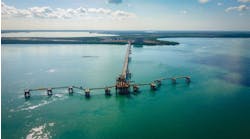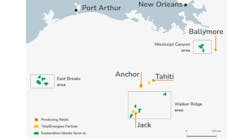Dragon lays foundations for growth at Turkmen offshore complex
Jeremy Beckman
Editor, Europe
Development of the Cheleken Contract Area (CCA) fields off Turkmenistan has entered a new phase. After years of painstaking rehabilitation of the fields’ Soviet-era platforms and wells, operator Dragon Oil aims to step up production by expanding interfield and export infrastructure and rig capacity.
The company, headquartered in Dubai, signed a 25-year production-sharing agreement for the CCA in November 1999 (effective from May 2000) with Turkmenistan’s State Agency for the Management and Use of Hydrocarbon Resources. Under the PSA, recovered oil and gas is shared between the two parties according to the level of production at a given time. As operator, Dragon Oil is obliged to supply all capital and expertise for development and exploration programs.
The new Dzheitune (Lam) B platform. Dragon has since commissioned a further two new wellhead and production platforms.
Estimates of remaining resources change as more wells and workovers are completed. The latest assessment by independent consultants upgraded recoverable oil and condensate to 639 MMbbl, compared with 617 MMbbl at end-2009. This is due to an increase in proven reserves in the Dzheitune (Lam) West area and additional condensate to be extracted from the CCA’s gas reserves (currently booked estimate: 1.6 tcf) once a planned onshore gas treatment plant becomes operational. Presently, all produced crude is exported via the nearby Aladja Jetty to Baku, primarily for onward delivery westwards through the Baku-Tbilisi-Ceyhan pipeline.
Improved throughput
Last year, Dragon contracted four drilling rigs to drill and complete 11 new wells or workovers. Two of the wells were drilled last spring from the newly installed Dzheitune (Lam) B platform by theAstra jackup. To date, four wells have been drilled and completed from this structure
During 2010, Dragon also concluded and commissioned various infrastructure projects. These included:
- Doubling the processing capacity of the offshore central processing facility to handle up to 100,000 b/d of liquids and up to 220 MMcf/d of (unprocessed) gas
- A new 30-in. (76-cm), 40-km (24.8-mi) multi-phase subsea trunkline to Aladja, replacing two existing 12-in. pipelines
- Additional interfield pipelines for the Dzheitune (Lam) field, between Platform 28 and Platform A (18-in., or 46 cm); Platform A to block 2 (20-in., or 51 cm); and Platform B to Platform 28 (14-in., or 35.6 cm). These provide increased throughput capacity and will accommodate future development of the western part of the CCA.
The effect of these measures has been to eliminate infrastructure bottlenecks and to improve daily flow rates at end-2010 (exit rate) to just over 57,000 b/d, up from the previous year’s exit rate of 49,698 b/d, and average production of 44,765 b/d during 2009.
Dragon also awarded construction contracts to local yards for two new wellhead and production platforms. ILK Insaat Taah, San. Ve. Tic is building the Dzheitune (Lam) C platform. Following completion late this year, it will be installed in the western part of the Dzheitune (Lam) field, targeting reserves beyond the reach of the existing Dzheitune (Lam) B and 28 platforms. It will be able to support a jackup rig, with up to eight slots for drilling.
Caspian Energy Projects LLC is building the Dzhygalybeg (Zhdanov), a platform and bridge-linked accommodations, which will be installed on the eastern part of the hitherto undeveloped Dzhygalybeg (Zhdanov) field following completion in early 2012. The drilling facility will be able to support a land rig and a jackup. At least eight wells and maybe more will be drilled from this platform depending on results from the first few wells.
Towards the end of 2011, a new Super M2 jackup, under construction at the Yantai Raffles Offshore yard in Singapore, will be dispatched in various consignments to the Caspian Sea for subsequent re-assembly at one of the region’s shipyards. Yantai Raffles’ contract extends to lease and management of the rig, which is more powerful than any in Dragon’s current drilling fleet and capable of drilling wells faster and more efficiently, the company says.
For this year’s campaign, Dragon has retained the land rigsNIS and Rig 40 to drill up to seven wells from the Dzheitune (Lam) 28 and 13 platforms. The extension of the contract for the jackup Iran Khazar has been agreed in principle for two years, with up to four wells in 2011 from the Dzheitune (Lam) B platform. Another jackup involved in last year’s program, Astra, could be brought in again.
Dragon plans to maintain its rolling program of drilling and workovers from existing platforms.
“We add slots on an ongoing basis,” the spokesperson says, “taking into account drilling results from the previous wells on that platform, new spots we could target and so on.”
The reservoir is complex, requiring use of dual-completion and high-angle extended reach wells to maximize production, combined with 3D seismic imaging and reservoir simulation. The company also looks to target new reserves in the Cheleken Extension Area, although plans are currently on hold until a suitable jackup becomes available.
Gas studies
Dragon is producing around 120 MMcf/d of associated gas, most of which is flared. However, following the improvements to the central processing facility and other new investments, the company has started bringing unprocessed gas to the shore through the new 40-km (25-mi) trunkline for onward export into the Turkmen gas network, once facilities such as the compressor station and a connecting pipeline are completed.
For 2011-13, the company has budgeted a further $600-700 million for oilfield facilities and $150-170 million on gas development. The long-term plan for the CCA area involves phased installation of further new wellhead platforms and related infield lines. Dragon has commissioned a generic FEED study to devise a template that would serve to improve and standardize platform design with a view to optimizing drilling and cutting construction costs.
Offshore Articles Archives
View Oil and Gas Articles on PennEnergy.com




